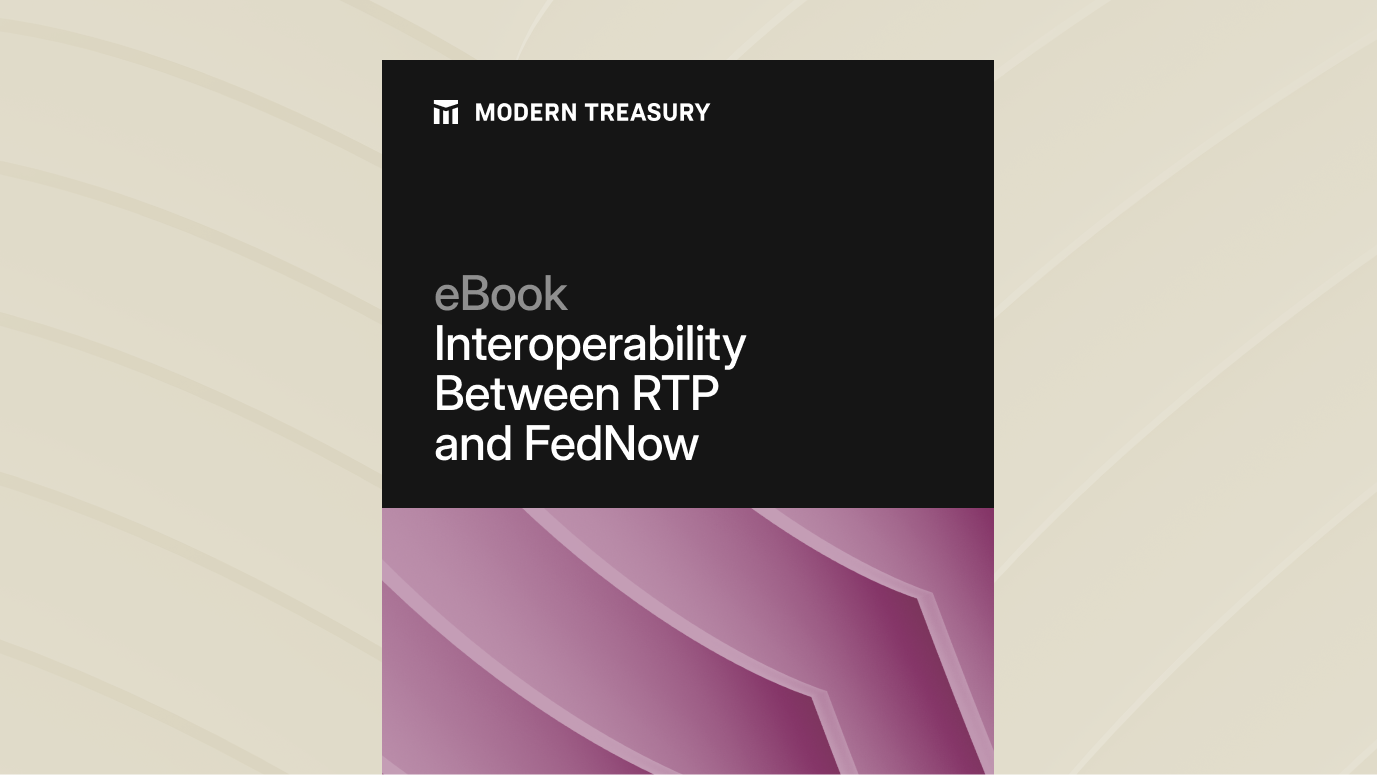Join us at Transfer 2025 to hear how industry leaders are building payments infrastructure for a real-time world.Register Today →
Why Faster Payment Rails Are Game Changing for US Payments
Faster payment rails like RTP and FedNow are about to remake domestic money movement. This journal explores how faster payments are different and what the near future could look like.

Money movement in the US is evolving, with big changes on the near horizon. Real Time Payments (RTP), introduced in 2017, marked an inflection point as the first new domestic bank rail in over 40 years. And with the introduction of instant payments and settlement, RTP moved the US one step closer to capabilities long available abroad. FedNow, coming between May and July of 2023, will make faster payments more widely available and may forever transform how companies and consumers move money.
With major shifts so close at hand, it’s time to understand options and explore opportunities; now is the moment when businesses should begin to prepare for faster payments. In this journal, we’ll discuss faster payment rails vs. traditional bank rails, and dig into how adoption of instant payments will revamp money movement for good.
Faster Payment Rails vs. Traditional Bank Rails: 3 Major Differences
Faster payments have three primary qualities: speed (instant), availability (24x7x365), and confirmation (immediate for sender and recipient).
Because of these attributes, faster payments require rails that are distinct from traditional bank rails. The latter refers to infrastructure supporting ACH—the most widely used payment processing network in the US—which is characterized by batch processing, extended settlement times, and reversibility. Let’s examine how these three qualities are upended by faster payments technology.

1. Processing (Batch vs. Transaction)
Traditional rails use batch processing for ACH. This means that the relevant financial institutions (or FIs) compile and batch ACH transactions before sending them to one of two clearing houses—the Federal Reserve or EPN (the Electronic Payments Network)—in bulk. For traditional ACH, this usually happens daily before end-of-business on east coast time; for Same Day ACH, batches are processed throughout the day.
Batch processing makes sense for FIs, when you consider ACH transaction volume, because of cost. In 2021, Nacha processed 29.11 billion ACH payments, of which 5.32 billion payments were B2B (a total of $49.79T transferred).
Still, batch processing results in delays. Standard timelines for traditional ACH allow up to three days for payment processing; Same Day ACH should require a single business day, depending on the bank and cut-off times. Despite this, according to our recent report, 48% of financial decision-makers say it takes longer than two to three days for traditional ACH to post and 60% say Same Day ACH takes more than a day.
Transaction processing, on the other hand, works as the name implies—payment files are processed as they come in, on a per transaction basis in real-time.
This dramatically increases the speed with which funds can move; the anatomy of a faster payment includes progress through initiation, authorization, transmission, acceptance, and receipt at a nearly instant clip, payment by payment. As a result, this can change how payments are ledgered (in real-time as opposed to in batch). This also presents new challenges for compliance programs, as better controls, counterparty risk assessment, and transaction monitoring mechanisms are needed.
Key benefit: Faster payments radically reduce bank processing time due to batch processes. Money can move 24x7x365.
2. Settlement Times
Clearing and settlement processes are also distinct for faster payments. With ACH, the messages that constitute clearing on traditional bank rails happen at scheduled intervals. In the case of faster payments, clearing happens transaction by transaction in adherence with ISO20022—this messaging cadence and an agreement between FIs enable payments to be credited in real-time.
ACH is processed via deferred settlement, meaning that settlement happens at designated times or on a specific schedule.
Faster payments use real-time settlement; this means settlement happens at nearly the same time as clearing, on a per transaction basis.
This type of settlement is also considered a gross settlement, where FIs clear and settle funds transaction by transaction. For traditional bank rails processing ACH, deferred settlement utilizes netting (or net settlement), which entails aggregating payments between the same parties to prevent the depletion of reserves.
In the simplest terms, real-time gross settlement (used for RTP and planned for FedNow) is much faster with different implications from deferred net settlement when it comes to liquidity and credit risk.
Key benefit: Funds are available faster. In addition to back office efficiency and customer delight, the ability to move money quickly can have tremendous impacts (in emergencies, for example).
3. Finality vs. Reversibility
Whereas over traditional bank rails, an ACH can be reversed or returned, when faster payment rails process funds, the transactions are final, and thus, money is guaranteed.
Faster payments are primarily credit (or push) payments, with security that a payer will only be able to initiate payment if their account contains sufficient funds.
This protection means businesses can avoid common chargebacks on returns like insufficient funds (NSF).
In order to debit (or pull) a real-time payment, an RFP (or request for payment) is required. The more robust the data and parameters of the RFP, the less likely errors become—errors that might, in the case of ACH, warrant a reversal. As an example, if the amount requested in the RFP is correctly entered by the payee and can’t be edited by the payer, mistakes become much less likely. For FedNow, “amount due” will be a required field in RFPs. This will also make it easier to ledger transactions as they happen and simplify reconciliation.
Key benefit: Because faster payments are final, businesses can count on funds being available and also access a clearer financial picture. Companies can further avoid the hassles associated with returns and reversals.
How Wide Adoption of Faster Rails Could Affect Businesses
Let’s explore two practical examples of how faster payments could help improve operations for companies that adopt the technology.
Better Efficiency and Fewer Errors
In addition to back office benefits afforded by instant, non-reversible availability of funds, faster payment rails can mitigate pain points.
Faster payments help teams in B2B scenarios (especially those in A/P and A/R) correctly track and post incoming funds (and thus avoid having to reverse errors).
Suppose Angie is paying her company’s office internet bill and doesn’t supply the correct remittance data—perhaps she provides an incorrect account number or doesn’t include an identification number that corresponds with her bill. As a result, the internet service company’s A/R team could credit the wrong account or show the wrong bill as paid. Angie could be billed again and charged a late fee—and the A/P team could pay the same bill twice.
With a faster payments RFP that includes remittance data and allows Angie to settle her account right away, the potential for this error (not to mention the time lost and damage to customer relationships) is greatly reduced. Further, sending customers an e-invoice for faster payments helps their A/P system improve efficiency and reduce mistakes with easier record-keeping.
Increased Customer Convenience
Along similar lines, faster payments are a boon for customers who may need to closely manage outgoing funds.
In the case of B2C, faster payments could radically transform the spending (and lives) of customers, especially those living paycheck to paycheck.
And what financially serves people ultimately supports companies as well.
Suppose Dean’s gas bill is due Wednesday but he gets paid on Friday. With faster payments, Dean could potentially get paid every day at the end of this shift so he wouldn’t have to wait to make a payment. In the case of his gas bill, this scenario would help Dean avoid late fees and potential shutoffs. For the gas company, faster payments could decrease missed payments and lessen customer support needs (specifically, to field complaint calls about fees or shutoffs). Dean’s customer satisfaction is also likely to increase, boosting retention, if he can make an instant payment that clears immediately on his own timeline.
Companies that have enabled faster payments can send Dean a QR code that contains an RFP so he can use his mobile banking app to pay the gas bill right away, as soon as he has the funds. And allowing customers more control over when payments are made goes a long way towards curbing NSF and dealing with potential compliance issues.
Looking Ahead: Partnering for Faster Payments
Faster payment rails are poised to transform the way money moves in the US. Still, this major shift will only be possible if companies make the right arrangements soon. Modern Treasury was founded to help businesses seamlessly manage payments for years to come—and we’re well-prepared to get your business set up for the next era of faster payments technology today. Reach out to connect with our sales team.
While traditional bank rails handle a variety of payment types, including wires and checks, for the purposes of this comparison, we’ll focus on the ACH process.
Access the 2022 State of Payment Operations Report here.
It's Time For an Upgrade
96% of financial decision makers plan to invest in payment operations in the next 12–18 months.







